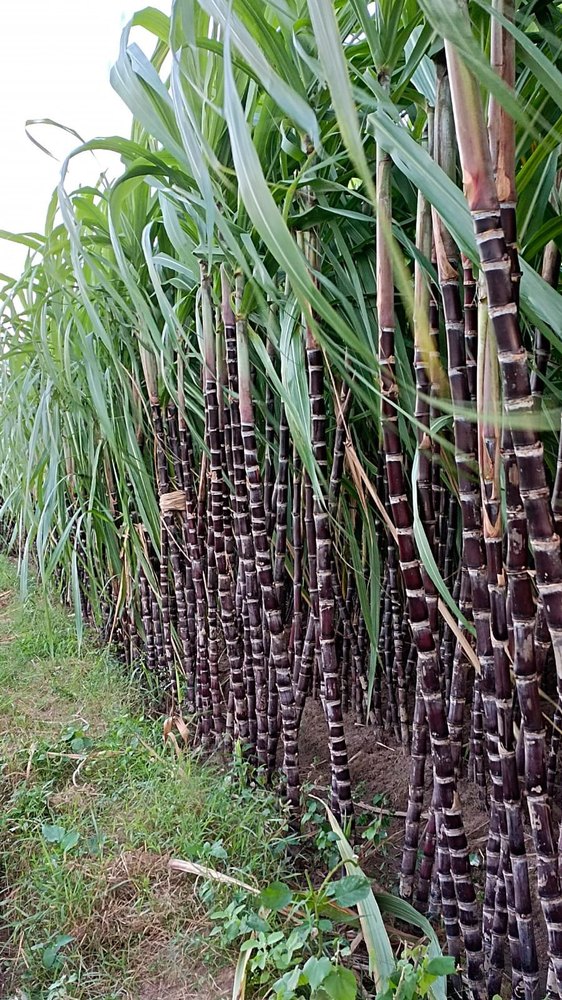Saccharum officinarum

|
|
Saccharum officinarum Common Names: Sugarcane, Noble Cane Scientific
Classification Kingdom: Plantae Phylum: Tracheophyta Class: Liliopsida Order: Poales Family: Poaceae Genus: Saccharum Species: S. officinarum Synonyms: Saccharum robustum Brandes & Jesw. ex Grassl, Saccharum spontaneum L. (partial synonymy in hybrids) Morphological Description Saccharum officinarum is a tall, perennial C4 grass, typically growing 2–6 m high,
with a robust, fibrous root system. Its key features include: · Stem: Stout, jointed culms, 3–5 cm in diameter, rich in sucrose
(10–20% by weight), green to reddish · Leaves: Linear-lanceolate, 0.7–1.5 m long, 4–7 cm wide, with
serrated margins and a prominent midrib · Inflorescence: Terminal panicle, 0.3–1 m long, plume-like, whitish-grey to
pinkish, with spikelets bearing silky hairs · Roots: Adventitious, forming dense mats aiding water uptake The plant’s high sucrose
content distinguishes it from wild relatives (Fern, 2024). Distribution and Habitat Saccharum officinarum originated in New Guinea, domesticated around 6000 BP
from S. robustum.
It is now cultivated pantropically, from India to Brazil, in: · Regions: Tropical and subtropical zones (latitudes 35°N–35°S) · Climate: Warm (25–35°C), humid (rainfall 1,000–2,000 mm annually) · Soils: Moist, well-drained loams or clays (pH 5.5–7.5) It thrives in full sun
and is rarely found wild due to extensive cultivation (Daniels & Roach,
1987). Ethnopharmacology Saccharum officinarum, commonly known as sugarcane, has been traditionally utilized in
various cultures for its medicinal properties. In Indian traditional medicine,
sugarcane juice is employed to treat conditions such as jaundice, hemorrhage,
dysuria, anuria, and other urinary diseases. Phytochemical analyses have
identified compounds like flavonoids and anthocyanins in sugarcane, which
exhibit strong antioxidant properties, contributing to hepatoprotective effects
against liver injuries. Additionally, sugarcane extracts have demonstrated
antibacterial activity, particularly against gram-negative bacteria, suggesting
potential in managing bacterial infections. Furthermore, studies indicate that sugarcane
may possess psychostimulant and anxiolytic-like effects, potentially enhancing
motor performance through dopaminergic pathways. These findings underscore the
diverse therapeutic potential of Saccharum officinarum, supporting its
traditional use in various medicinal applications. · Diuretic: In India, juice treats urinary tract infections; For
instance, research evaluating the aqueous extract of sugarcane leaves in rats
demonstrated a significant increase in urine output, indicating notable
diuretic activity. (Severin et al., 2023). · Respiratory Relief: In Nigeria, juice with honey soothes sore
throats. · Energy Booster: In Brazil, juice combats fatigue; it
provides 64 kcal/100 mL due to sucrose (Fern, 2024). · Antioxidant: Juice contains flavonoids (e.g., apigenin) and phenolics
(13.5 mg GAE/100 mL), reducing oxidative stress by 30% in vitro (Singh et al.,
2015). · Antipyretic: In Ayurveda, juice lowers fever; linked to cooling
properties and polyphenols (Karthikeyan & Samipillai, 2010). ⚠ Toxicity Profile: Sugarcane is non-toxic, but improperly stored
molasses may contain biogenic amines (e.g., tyramine), causing headaches at
>100 mg/kg intake. Overconsumption of refined sugar risks obesity and
diabetes (Daniels & Roach, 1987). Additional Uses · Economic: Supplies 70% of global sugar (1.9 billion tons annually) and
ethanol (25% of biofuel) (FAO, 2023). · By-products: Bagasse powers 30% of sugarcane mills’ electricity; used in
paper and feed. · Environmental: Enhances soil fertility in rotations; reduces erosion by 20%
compared to bare land (Singh et al., 2015). References
External Links More Pictures
|
|
| Compounds of Saccharum officinarum |
|
| References |